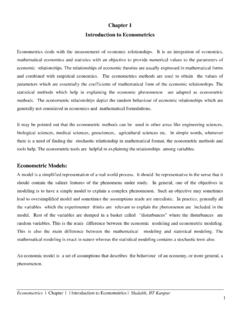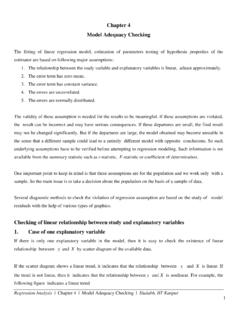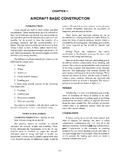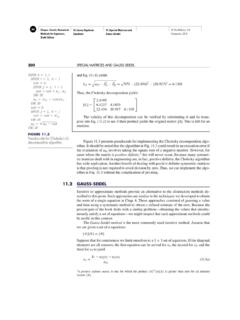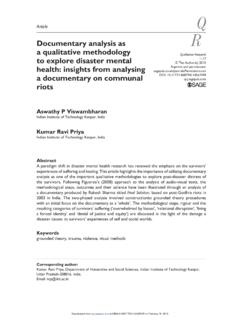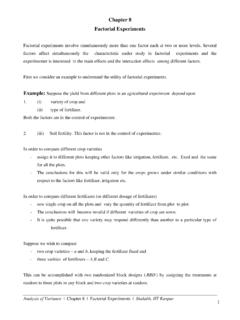Transcription of Chapter 11 Systematic Sampling - IIT Kanpur
1 Chapter 11. Systematic Sampling The Systematic Sampling technique is operationally more convenient than the simple random Sampling . It also ensures at the same time that each unit has equal probability of inclusion in the sample. In this method of Sampling , the first unit is selected with the help of random numbers and the remaining units are selected automatically according to a predetermined pattern. This method is known as Systematic Sampling . Suppose the N units in the population are numbered 1 to N in some order. Suppose further that N is expressible as a product of two integers n and k , so that N = nk.
2 To draw a sample of size n , - select a random number between 1 and k . - Suppose it is i . - Select the first unit whose serial number is i . - Select every k th unit after i th unit. - Sample will contain i, i + k ,1 + 2k ,.., i + (n 1)k serial number units. So first unit is selected at random and other units are selected systematically. This Systematic sample is called kth Systematic sample and k is termed as Sampling interval. This is also known as linear Systematic Sampling . The observations in the Systematic Sampling are arranged as in the following table: Systematic sample 1 2 3 i k number Sample 1 y1 y2 y3 yi yk composition 2 yk +1 yk + 2 yk + 3 yk + i y2k.
3 Y( n 1) k +1 y( n 1) k + 2 y( n 1) k +3 y( n 1) k +i ynk n . Probability 1 1 1 1 1. k k k k k Sample mean y1 y2 y3 yi yk Sampling Theory| Chapter 11 | Systematic Sampling | Shalabh, IIT Kanpur Page 1. Example: Let N = 50 and n = 5. So k = 10. Suppose first selected number between 1 and 10 is 3. Then Systematic sample consists of units with following serial number 3, 13, 23, 33, 43. Systematic Sampling in two dimensions: Assume that the units in a population are arranged in the form of m rows and each row contains nk units. A sample of size mn is required. Then - select a pair of random numbers (i, j ) such that i and j k.
4 - Select the (i, j )th unit, , j th unit in i th row as the first unit. - Then the rows to be selected are i, i + , i + 2 ,.., i + (m 1) . and columns to be selected are j , j + k , j + 2k ,.., j + (n 1)k . - The points at which the m selected rows and n selected columns intersect determine the position of mn selected units in the sample. Such a sample is called an aligned sample. Alternative approach to select the sample is - independently select n random integers i1 , i2 ,.., in such that each of them is less than or equal to . - Independently select m random integers j1 , j2 ,.., jm such that each of them is less than or equal to k.
5 - The units selected in the sample will have following coordinates: (i1 + r , jr +1 ), (i2 + r , jr +1 + k ), (i3 + r , jr +1 + 2k ),.., (in + r , jr +1 + (n 1)k ) . Such a sample is called an unaligned sample. Under certain conditions, an unaligned sample is often superior to an aligned sample as well as a stratified random sample. Advantages of Systematic Sampling : 1. It is easier to draw a sample and often easier to execute it without mistakes. This is more advantageous when the drawing is done in fields and offices as there may be substantial saving in time. 2. The cost is low and the selection of units is simple.
6 Much less training is needed for surveyors to collect units through Systematic Sampling . 3. The Systematic sample is spread more evenly over the population. So no large part will fail to be represented in the sample. The sample is evenly spread and cross section is better. Systematic Sampling fails in case of too many blanks. Sampling Theory| Chapter 11 | Systematic Sampling | Shalabh, IIT Kanpur Page 2. Relation to the cluster Sampling The Systematic sample can be viewed from the cluster Sampling point of view. With n = nk , there are k possible Systematic samples. The same population can be viewed as if divided into k large Sampling units, each of which contains n of the original units.
7 The operation of choosing a Systematic sample is equivalent to choosing one of the large Sampling unit at random which constitutes the whole sample. A. Systematic sample is thus a simple random sample of one cluster unit from a population of k cluster units. Estimation of population mean : When N = nk: Let yij : observation on the unit bearing the serial number i + ( j 1)k in the population, i = 1, 2,.., k , j = 1, 2,.., n. Suppose the drawn random number is i k . Sample consists of i th column (in earlier table). Consider the sample mean given by 1 n ysy= y=. i yij n j =1. as an estimator of the population mean given by 1 k n Y = yij nk=i 1 =j 1.
8 1 k = yi . k i =1. 1. Probability of selecting i th column as Systematic sample = . k So 1 k =. E ( ysy ) = yi Y . k i =1. Thus ysy is an unbiased estimator of Y . Further, 1 k =. Var ( ysy ) . k i =1. ( yi Y ) 2 . Sampling Theory| Chapter 11 | Systematic Sampling | Shalabh, IIT Kanpur Page 3. Consider k n ( N 1)=. S2 ( y =i 1 =j 1. ij Y )2. k n 2. = ( yij yi ) + ( yi Y ) . =i 1 =j 1. k n k = ( yij yi )2 + n ( yi Y )2. =i 1 =j 1 =i 1. k =k (n 1) S wsy 2. + n ( yi Y ) 2. i =1. where k n 1. = 2. S wsy ( yij yi )2. k (n 1)=i 1 =j 1. is the variation among the units that lie within the same Systematic sample.
9 Thus N 1 2 k (n 1) 2. =. Var S . ( ysy ) S wsy N N. N 1 2 (n 1) 2. = S S wsy N n . Variation Pooled within as a variation of the whole k Systematic sample with N = nk . This expression indicates that when the within variation is large, then Var ( yi ) becomes smaller. Thus higher heterogeneity makes the estimator more efficient and higher heterogeneity is well expected in Systematic sample. Alternative form of variance: 1 k =. Var ( ysy ) . k i =1. ( yi Y ) 2. 2. 1 k 1 n . = yij Y . n j 1. k i 1=. = . 1 k n . 2 . = ( yij Y ) . j 1. kn=i 1 = . 1 n k n n . = kn 2. ij i= 1 j= 1. ( y Y ) 2.
10 + ( yij Y )( yi Y ) . j ( )= 1 = 1 . 1 k n n . = 2. kn . ( nk 1) S 2. + ( yij Y )( yi Y ) . i = 1 j ( )= 1 = 1 . Sampling Theory| Chapter 11 | Systematic Sampling | Shalabh, IIT Kanpur Page 4. The intraclass correlation between the pairs of units that are in the same Systematic sample is E ( yij Y )( yi Y ) 1. = w ; w 1. E ( yij Y ) 2. nk 1. k n n 1. ( yij Y )( yi Y ). nk (n 1) i = 1 j ( ) = 1 = 1. = . nk 1 2. S. nk . So substituting k n n (y i = 1 j ( )= 1 = 1. ij Y )( yi Y ) = (n 1)(nk 1) w S 2. in Var ( yi ) gives nk 1 S 2. Var (=. ysy ) [1 + w (n 1)]. nk n N 1 S 2. = [1 + w (n 1)]. N n Comparison with SRSWOR: For a SRSWOR sample of size n , N n 2.
